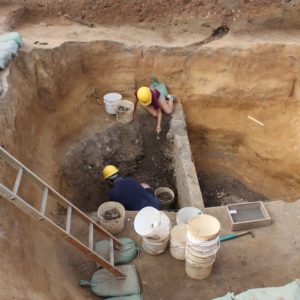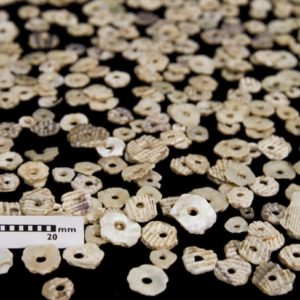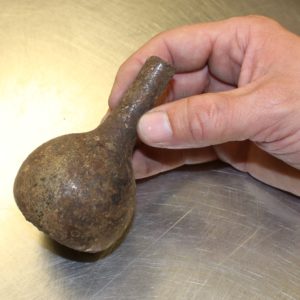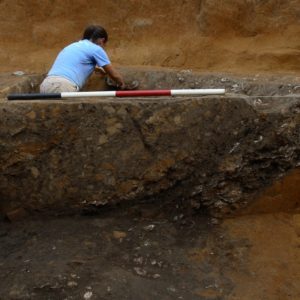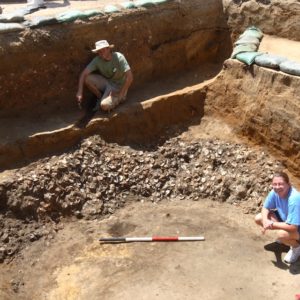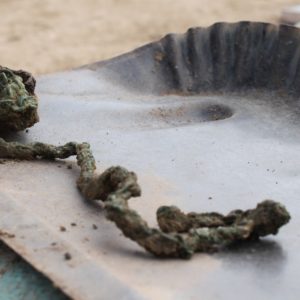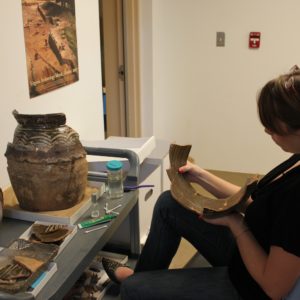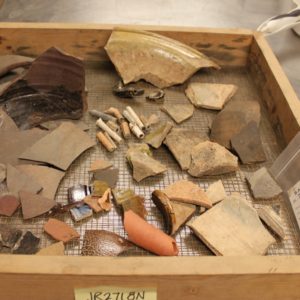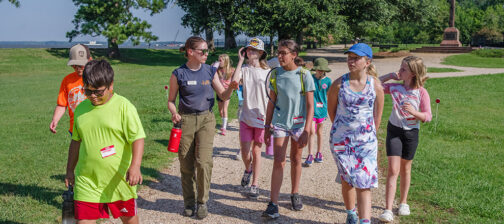Digging deeper and deeper into a well near the center of James Fort, the Jamestown Rediscovery archaeological team continues to find hundreds of artifacts each day as their excavations give shape to what was probably the fort’s first well, built under the direction of Captain John Smith in early 1609. Archaeologists have found four distinct corners carved into the soil, which is five feet below the starting grade of the excavation. These four corners can be seen just above the well shaft, and it is believed this is evidence of a structure enclosing the well shaft and for a cellar component just above it. Furthermore, there is evidence that the well/cellar was connected to the storehouse immediately adjacent to it and may have had a roof that was an extension of the storehouse’s. As these discoveries are made, artifacts continue to be found in droves. Among the latest are a jet crucifix, a whale vertebra, a dolphin jaw bone, two large turtle shells, and a large Donyatt-type earthenware jar made in Somerset County, England.
Four distinct corners have been found which define the underground space above the actual well shaft. The Jamestown Rediscovery team believes that the corners supported a timber-framed structure above the well shaft that was probably connected to the storehouse just a few feet away. Between two substantial postholes from the storehouse structure there may have been a passageway connecting the well/cellar to the storehouse structure. The underground room housing the well shaft may have been used as a cellar for keeping provisions cool. The archaeologists haven’t found any steps carved into the soil to allow people to access the well and this indicates that wooden stairs or a ladder were probably used. Furthermore, no wood stains have turned up so far in the well excavations, suggesting that the wood supporting the structure was removed (and probably reused) before it began to decay.
Over 26,000 oyster shells have been found in the well. That so many oyster shells were found in such a relatively small space seems to suggest that they were all dumped in the well at the same time. The shells may have been part of a relief supply of food gathered downriver and delivered shortly after the Starving Time by either Sir Thomas Gates’ or Lord Delaware’s fleets. Julie Harding, a researcher with the Virginia Institute of Marine Science, is studying the shells in order to learn when and from where the oysters were harvested. Hopefully her research will be able to shed some light on the nature of this huge amount of shells found in the well.
Many other marine life remains have been found in the well. Thousands of fish bones have been discovered, including scutes from the large sturgeon that were so plentiful in the James at the time of the colonists’ arrival. More shark vertebrae have been found as well. Marine mammal bones have also been found in the well recently, including whale and dolphin vertebrae and the butchered jaw bone of a bottlenose dolphin. The butchering marks on the jaw bone indicate that the dolphin was eaten. Two large marine turtle shells have been excavated from the well also.
A large Donyatt-type earthenware jar was found in the well and is currently being mended by the curatorial team. A thumb-impressed rim and wet-sgraffito decoration adorn the large vessel, which had been thrown in two parts and luted together. Donyatt is a village in southwest Somerset County, England and archaeological excavations there have unearthed similar jars from kilns dating ca. 1600-1650.
related images
- Archaeologists Dan Smith and Patricia Searl digging in the well
- Assortment of shell beads
- Archaeologist Dan Smith excavates a copper chain in the well
- Dolphin bones and whale vertebra
- Glass receiver
- Patricia Searl digging in the well
- Archaeologist Danny Schmidt and VIMS researcher Julie Harding with some of the 26,000 oyster shells that have been found in the well
- Burned cloth and rope
- A tiny Venetian glass bead, one of several found in the well
- Copper chain
- Curatorial Assistant Kelsey Noack mends a large Donyatt-type jar
- Assorted ceramic finds
- Fragments of a marine turtle shell
- Bone finds from the well (clockwise from the top-left) whale vertebra, land mammal vertebra, fish vertebra, shark vertebra, dolphin vertebra



